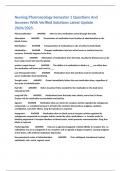Nursing Pharmacology Semester 1 Questions And
Answers With Verified Solutions Latest Update
2024/2025.
Pharmacokinetics - ANSWER refers to how medications travel through the body.
Absorption - ANSWER Transmission of medication from location of administration to the
blood stream.
Distribution - ANSWER Transportation of medications to site of action by body fluids.
Metabolism - ANSWER Changes medications into less active forms or inactive forms by
enzymes. Primarily happens in the liver.
Excretion - ANSWER Elimination of medications from the body. Usually the kidneys but can be
liver, lungs, bowel and exocrine glands.
protein, target tissues - ANSWER The ability of a medication to bind to a ___ can effect how
the medication will leave and travel to ___
Low Therapeutic Index - ANSWER Medications have this and they must be monitored by
serum medication level monitoring
Trough Levels - ANSWER Drawn immediately before the next medication dose, regardless of
the route of administration.
Half Life - ANSWER Refers to period f time needed for the medication in the body to be
reduced by 50%
Long Half Life - ANSWER Medications leave the body more slowly; more than 24 hours.
Greater risk for medication accumulation and toxicity.
Agonist - ANSWER Medication that can mimic the receptor activity regulated by endogenous
compounds. i.e. morphine because it activates the receptors that produce analgesia, sedation,
constipation, and other effects. drug that produces a response
Antagonist - ANSWER Medication that can block normal receptor activity regulated by
endogenous compounds or receptor activity caused by other medications. i.e. losartin works by
blocking angiotensin II receptor blockers on blood vessel, which prevents vasoconstriction. Drug that
blocks a response
Partial Agonists - ANSWER May act as agonist/antagonist. Limited affinity to receptor site. i.e.
nalbuphine acts as an antagonist at mu receptors and an agonist at kappa receptors, causing analgesia
at low doses, with minimal respiratory depression.
Non-parenteral routes of Administration - ANSWER Oral, sublingual, transdermal, topical,
opthalamic, otic, rectal, vaginal, nasal.
, Therapeutic Effect - ANSWER This is the preferred and expected effect for which the
medication is administered to a specific client.
Side Effects - ANSWER Usually expected and inevitable when a medication is administered at
a therapeutic dose.
Adverse Effects - ANSWER There are undesired, inadvertent, and unexpected dangerous
effects of the medication.
Toxic Effects - ANSWER Medications can have specific risks and manifestations of toxicity.
Components of a prescription - ANSWER Clients full name, date and time of prescription,
name of medication, dosage of medication, route of administration, time and frequency, signature of
provider.
Six Rights of Safe Medication Administration - ANSWER Right Client, Right Drug, Right Dose,
Right Time, Right Route, Right Documentation.
Diabetes mellitus - ANSWER Chronic illness that results from an absolue or relative deficiency
of insulin, often combined with cellular resistance to insulin's actions.
Rapid-acting - ANSWER Humalog. Onset less than 15 minutes; peak 30min-1hr; Duration 3-4
hours
Short-acting - ANSWER Regular (Humulin R). Onset 30min-1hr; Peak 2-3 hr; Duration 5-7hr
Intermediate-acting - ANSWER NPH (Humulin N). Onset 1hr; Peak 4-12 hr; duration 18-24 hr.
Long-acting - ANSWER insulin glargine (Lantus,Levemir). Onset 1hr; has no peak; duration
24hr
The purpose of insulin - ANSWER promote cellular uptake of glucose, converts glucose into
glycogen, and moves potassium into cells (along with glucose).
Diabetic Ketoacidosis - ANSWER One of the most serious complications of hyperglycemia.
Caused by drawing fluid out of the cell into circulation, excreted by kidneys. Results in Polyuria,
dehydration & electrolyte imbalance. This increases fat metabolism and ketones, resulting in
metabolic acidosis.
Hyperglycemic nonketotic syndrome - ANSWER blood glucose level about 600mg/dl resulting
in diabetic coma
Hypoglycemia acute onset - ANSWER low blood glucose level. symptoms in include;
tachycardia, palpitations, diaphoreses, shakiness
Hypoglycemia gradual onset - ANSWER low blood glucose level. symptoms include; headache,
tremors, weakness,
Metformin (Glucophage) - ANSWER Reduces production of glucose from the liver by
suppression of gluconeogenesis. In a nut shell it prevents glucose from being made and forces body to





